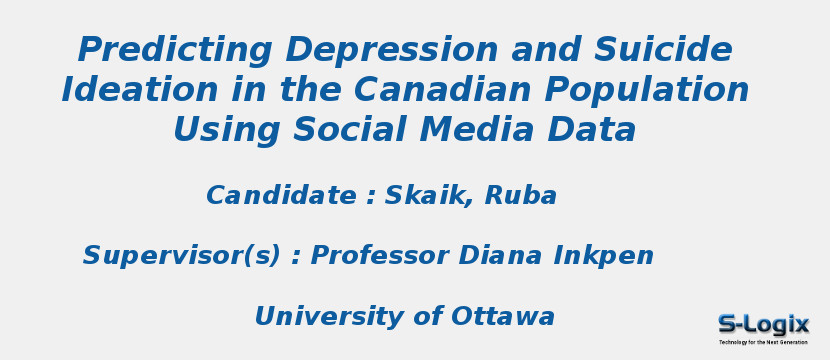Research Area: Machine Learning
The economic burden of mental illness costs Canada billions of dollars every year. Millions of people suffer from mental illness, and only a fraction receives adequate treatment. Identifying people with mental illness requires initiation from those in need, available medical services, and professional experts time allocation. These resources might not be available all the time. The common practice is to rely on clinical data, which is generally collected after the illness is developed and reported. Moreover, such clinical data is incomplete and hard to obtain. An alternative data source is conducting surveys through phone calls, interviews, or mail, but this is costly and time-consuming. Social media analysis has brought advances in leveraging population data to understand mental health problems. Thus, analyzing social media posts can be an essential alternative for identifying mental disorders throughout the Canadian population. Big data research of social media may also endorse standard surveillance approaches and provide decision-makers with usable information. More precisely, social media analysis has shown promising results for public health assessment and monitoring. In this research, we explore the task of automatically analysing social media textual data using Natural Language Processing (NLP) and Machine Learning (ML) techniques to detect signs of mental health disorders that need attention, such as depression and suicide ideation. Considering the lack of comprehensive annotated data in this field, we propose a methodology for transfer learning to utilize the information hidden in a training sample and leverage it on a different dataset to choose the best-generalized model to be applied at the population level. We also present evidence that ML models designed to predict suicide ideation using Reddit data can utilize the knowledge they encoded to make predictions on Twitter data, even though the two platforms differ in the purpose, structure, and limitations. In our proposed models, we use feature engineering with supervised machine learning algorithms (such as SVM, LR, RF, XGBoost, and GBDT), and we compare their results with those of deep learning algorithms (such as LSTM, Bi-LSTM, and CNNs). We adopt the CNN model for depression classification that obtained the highest F1-score on the test dataset (0.898) and 0.941 recall. This model is later used to estimate the depression level of the population. For suicide ideation detection, we used the CNN model with pre-trained fastText word embeddings and linguistic features (LIWC). The model achieved an F1-score of 0.936 and a recall of 0.88 to predict suicide ideation at the user-level on the test set. To compare our models predictions with official statics, we used 2015-2016 population based Canadian Community Health Survey (CCHS) on Mental Health and Well-being conducted by Statistics Canada. The data is used to estimate depression and suicidality in Canadian provinces and territories. For depression, (n=53,050) respondents filled in the Patient Health Questionnaire-9 (PHQ-9) from 8 provinces/territories. Each survey respondent with a score ≥ 10 on the PHQ-9 was interpreted as having moderate to severe depression because this score is frequently used as a screening cut-point. The weighted percentage of depression prevalence during 2015 for females and males of the age between 15 to 75 was 11.5% and 8.1%, respectively (with 54.2% females and 45.8% males). Our model was applied on a population-representative dataset that contains 24,251 Twitter users who posted 1,735,200 tweets during 2015 with a Pearson correlation of 0.88 for both sex and age within the seven provinces and NT territory included in the CCHS. An age correlation of 0.95 was calculated for age and sex (separately) and our model estimated that 10% of the sample dataset has evidence of depression (58.3% females and 41.7% males). For the second task, suicide ideation, Statistics Canada (2015) estimated the total number of people who reported serious suicidal thoughts as 3,396,700 persons, i.e., 9.514% of the total population, whereas our models estimated 10.6% of the population sample were at risk of suicide ideation (59% females and 41% males). The Pearson correlation coefficients between the actual suicide ideation within the last 12 months and the predicted model for each province per age, sex, and both more than 0.62, which indicates a reasonable correlation.
Name of the Researcher: Skaik, Ruba
Name of the Supervisor(s): Professor Diana Inkpen
Year of Completion: 2021
University: University of Ottawa
Thesis Link: Home Page Url
